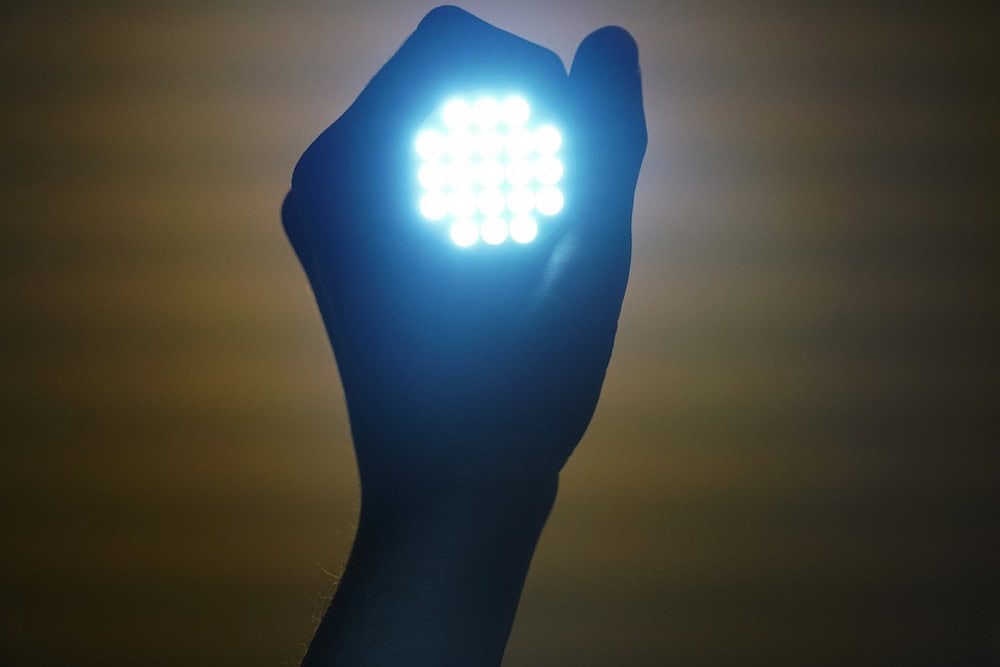
[Image] Creating blue LEDs is challenging, especially when they are blue perovskite LEDs. A new study could simplify the process and increase efficiency. Credit: Pixabay
When you think of researchers who have won the Nobel Prize in Physics, you may think of Einstein and his theories of relativity or Curie and her work on radioactivity. Yet there are dozens of Nobel Prize winners whose discoveries impact our lives on a daily basis that we rarely commemorate, such as Isamu Akasaki, Hiroshi Amano, and Shuji Nakamura.
These three scientists won the 2014 Nobel Prize in Physics for their work on blue light emitting diodes (LEDs), the catalyst invention that revolutionized electronic screens and allowed creation of white LEDs. Compared to red and green LEDs, blue LEDs have been around for a far shorter time because of the difficulties with developing a suitable semiconductor material.
Traditional LEDs work by passing an electric current through a semiconductor material, exciting electrons to jump to higher energy levels. Eventually, those electrons fall back to their original energy level, releasing a photon (light) in the process.
The larger the gap between energy levels, the more energy the emitted photon will have—which correlates to a shorter wavelength and determines the color of emitted light.
Gallium-based crystals like gallium arsenide and gallium phosphide are typical semiconductor materials used for LEDs. However, most of these crystals do not have large enough bandgaps to emit blue light. For example, gallium arsenide has a direct bandgap of 1.4 eV, which corresponds to the wavelength of infrared light.
Gallium nitride (GaN) does have a large enough bandgap to emit blue light: 3.4 eV, which correlates to a wavelength in the ultraviolet range. GaN LEDs are fairly recent—it wasn’t until the 1980s and 1990s that techniques to produce GaN with high crystal quality were developed, and Akasaki, Amano, and Nakamura could conduct their seminal research.
Advancements in GaN and other semiconductor materials continue to dominate the LED market, but interest in using other materials for LEDs have increased also. For example, perovskites.
A Science article on perovskite LEDs explains perovskite’s advantage to semiconductor materials: “The materials in current semiconductor LEDs, including the organic versions, require processing at high temperatures in vacuum chambers to ensure the resulting semiconductors are pristine. By contrast, perovskites can be prepared simply by mixing their chemical components in solution at room temperature. Only a brief heat treatment is needed to crystallize them.”
Yet in perovskites, as in semiconductor materials, it is difficult to achieve blue light emission.
Recent research on the composition, dimensionality, and processing of perovskite materials has led to the discovery of a few promising blue-emitting perovskite materials, including solutions of colloidal blue perovskite quantum dots and blue quasi-2D perovskite thin films. However, the high photoluminescence of colloidal quantum dots cannot be easily preserved once the dots are assembled into thin films, and quasi-2D perovskite thin films generally show poor charge transport properties.
But what if blue perovskite LEDs were created by combining nanoparticles and 2D layers? A new paper by researchers in China, the United Kingdom, and the United States answers that question—and the results are quite promising.
The researchers—from Zhejiang University, Beijing Institute of Technology, and Nanjing Tech University in China; University of Cambridge in the U.K.; and Argonne National Laboratory in the U.S.—made films of lead bromide perovskite nanoparticles embedded in a matrix of quasi-2D perovskites. They fabricated the material by sequential deposition of multiple layers onto indium tin oxide-coated glass substrates. In order, the layers were
- Nickel oxide,
- Poly(9,9-dioctylfluorene-co-N-(4-butylphenyl)-diphenylamine)/poly(9-vinlycarbazole),
- Perovskite,
- 2,2’,2” – (1,3,5-benzinetriyl)tris(1-phenyl-1H-benzimidazole),
- Lithium fluoride, and
- Aluminum.
The perovskite layer was deposited by an antisolvent-assisted approach from a precursor solution of phenylbutylammonium bromide, formamidinium bromide, cesium bromide, and lead bromide dissolved in dimethyl sulfoxide.
“The 2D perovskite has a large bandgap suitable for blue emission, but also electron-trapping defects,” a Chemical & Engineering News (C&EN) article on the research explains. “However, in the new films, nearly all of the excited electrons from the 2D perovskites pass into the nanoparticles, leading to blue emission at a wavelength of 483 nm. As a result, the efficiency of these blue LEDs is 9.5%. Commercial blue organic LEDs have an efficiency of about 5%.”
While this research presents a noteworthy improvement in the efficiency of blue perovskite LEDs, the LED’s efficiency dropped by half after shining for only four minutes. Yizheng Jin, professor of chemistry at Zhejiang University and coauthor of the study, explains in the C&EN article that short lifetime of perovskite LEDs is one of the most challenging hurdles to commercialization.
“Even for the most efficient green and red devices, the lifetime is limited to less than 200 hours,” he says.
In the future, the researchers plan to investigate the mechanisms behind efficiency loss and experiment with different material chemistries and nanostructures to increase efficiency and lifetime.
The paper, published in Nature Photonics, is “Efficient blue light-emitting diodes based on quantum-confined bromide perovskite nanostructures” (DOI: 10.1038/s41566-019-0505-4).
Author
Lisa McDonald
CTT Categories
- Electronics
- Energy
- Material Innovations

